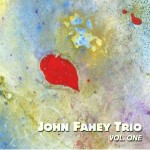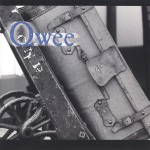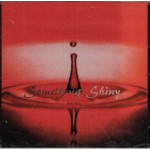 The John Fahey Trio
The John Fahey Trio
Vol. One
Jazzoo Records
Anyone familiar with or, more importantly perhaps, fond of the late Folk guitarist John Fahey (the fact that he died over a year ago is nowhere mentioned on this album, nor on any of the accompanying promotional material, but is alluded to, vaguely, in a few places) better tread lightly around this recording. It is entirely something different from the music for which he is renowned.
For the record, John Fahey died of kidney failure, following emergency heart surgery, on Feb. 22, 2001, six days before his 62nd birthday. Whether Fahey was completely cognizant of the fact that he would be releasing (posthumously) this first volume of “experimental” music, subsequent to his passing, is not entirely clear.
At this late date, one would suppose that he does not stand to gain much, monetarily, from its distribution. However, that is for the proper authorities to determine. So, though it is rather dubious as to whether we should mention it at all, in the interest of musical science, we must carry on our research.
Born and raised in Takoma Park, Maryland, John Fahey was a groundbreaking acoustic guitarist, who pioneered a whole style of Folk guitar. He adapted Delta Blues, Celtic and Indian Raga-like themes to his own idiosyncratic finger-picking techniques in the early ‘60s, long before they were popular. His recordings for the Takoma label (which he owned for a time) in the mid-‘60s, most notably 1965’s” The Transfiguration of Blind Joe Death,” and his series of Christmas albums, command a loyal, if somewhat small coterie of disciples.
His influence on guitarists who followed, especially Leo Kotke, and, supposedly, Thurston Moore of Sonic Youth, is indelible and undeniable. As time wore on however, the spotlight faded for Fahey, fueled in no small part by his abuse of alcohol. Ever the prolific musician however, he is known to have recorded, literally, dozens and dozens of albums.
Somehow, for some reason, Fahey ended up migrating to Oregon, where, for reasons unknown, he eventually surfaced at the Oregon Capitol Inn in the musical hotbed of Salem. Having grown up in the DC area, perhaps John was attracted to capitols. Be that as it may, he soon fell in with Tim Knight, the longtime owner of Music Castle music store— and Knight’s friend, guitarist Rob Scrivner.
Together they explored a mutual penchant for experimental music, inspired by the success of the likes of Sonic Youth, with whom Fahey toured in 1996, after releasing his “dissonant collage” recording “City Of Refuge.” These recordings, featuring Fahey, Knight and Scrivner, reflect.
Though Fahey still played the occasional Folk guitar gig, his career was clearly in a free-fall. It was Portland’s own Terry Robb, a true devotee of the Blues (of which some of Fahey’s music sometimes emulated) who helped to revive John’s flagging prospects, producing records in the mid ‘90s which recalled some of his former grandeur.
And there are places, even here, such as with the lovely “Hitomi Cries,” where you can hear the style for which he was famous. And “Like Being Reborn Again” intimates some of his former dobro work, in an earlier day. But the rest of it is a shapeless, free-form de-constructionist hodge-podge of disquiet and discord. It’s not necessarily bad— as that. But purists have surely been horrified to discover this aspect of Fahey’s musical personality. Still, that said, it is not to say that this recording is entirely without merit. But the boundaries of the new turf must be clearly defined at the outset.
There are pieces, such as the hymn-like “Things Fall Apart” and the mystical “The Center Will Not Hold” that rise above the random chaos of numbers such as “She.” And “Final Song Live,” which is of some archival value, features an interesting game of “sax guy in search of something to hold to,” that proves the mettle of guest reedman John Flaming. Other portions of pieces sometimes sound like the Captain Beefheart Magic Band of the ‘80s, without Captain Beefheart.
Perhaps of greatest historical significance here is “Oregon Capitol Inn,” where Fahey vocally offers an hallucinogenic explication of the history, geology and of his living quarters and the surrounding environs in Salem, wherein he repeatedly refers to the state as “Arra-Gawn.” Poor Oregon. The only mispronounced state in the union. We, the people, learned Massachusetts, Connecticut, Kansas and Arkansas; but the nation cannot pronounce these three sylables. It is a very sad state of affairs, indeed.
The other autobiographical number, “Tina In The Rain” finds Fahey lucidly, but inaudibly telling the story of how he learned “at the feet of the old Negro, Blind Joe Death,” (who eventually, ostensibly bequeathed to Fahey a guitar) his style of guitar playing, performed in a drone tuning, rather than the standard E-A-D-G-B-E tuning.
John Fahey is no longer around to explain, elucidate or enlarge upon this facet of his musical endeavors. It is unclear whether or not he would have one day succeeded at becoming an “avant-garde” guitarist: success and avant-garde guitarist being concepts which seem oxymoronically antithetical. Some of his ideas warrant scrutiny, other portions sound like immature anti-musical rants. But, at the point in his life that he had reached, he still felt the need to express himself, somehow, on the guitar. If this is actually the puzzling musical legacy he chose to leave, then so be it.
 Qwee
Qwee
Qwee
Hirngespinst Records
Qwee is the alter-ego of John Amadon, who, most recently, was the bassist for Fernando, performing on Viciconte’s Dreams Of The Sun. Joining Qwee on this project, is practically every sideman who appeared on Fernando’s album, including band mates, peripatetic keyboardist Ralph Huntley (of Tony Starlight), drummer Sean Oldham (who also plays with Richmond Fontaine), drummer Scott McPherson (toured with Elliott Smith and Neil Finn), guitarist Dan Eccles and, most importantly co-producer/multi-instrumentalist Mike Coykendall. Qwee contributes bass, guitar and vocals to his songs.
As a singer and songwriter, Qwee owes a debt to Neil Finn, who owed a debt to Paul McCartney, of course. The Beatles hover around this album as well: themes and influences shared with Elliott Smith, as well. But a gift for haunting melodic interludes stands as chief among Qwee’s talents. An outstanding production enhances the depth and scope of Qwee’s intelligently guileless songs.
Songs such as “Plastic Dream” and “She Isn’t Here” are dead-ringers for the work of Emmett Rhodes, leader of the ‘60s band Merry-Go-Round, who subsequently put out a couple albums in the early ‘70s, capitalizing on his uncanny ability to mimic McCartney, The driving piano rhythm of “Plastic Dream” recalls that of Rhodes’ minor-hit “Fresh As A Daisy.” Just try to find that one!
“These Dry Eyes” has a Neil Finn quality and “Anymore” calls to mind McCartney’s persistent boyishness. But beyond Qwee’s apparent stylistic influences, there is an emotional thread which weaves its way through the each song. Subtly a storyline unfolds, a familiar, unhappy tale of love gone asunder— and of the wreckage such upheaval leaves in its dark wake.
This album clearly moves through Elizabeth Kubler Ross’ “5 Stages Of Grief,” from the Denial phase of “Plastic Dreams,” the Anger of “Anymore,” Bargaining with “Let Go,” Depression with “Sunday Driving,” “Madness In The Way,” “The Paths Of Confusion” and “These Dry Eyes,” towards some sort of Acceptance, which Qwee reaches with the final track, “Time Has Something In Mind.” It’s a transcendent journey, with, hopefully a positive outcome in the end.
Stand-out tracks include the “The Bright Moon,” a Beatlesesque pastiche, wherein Qwee vocally captures both Lennon and McCartney, while guest Joe Chiusano adds the vital third part to angelic harmonies. “Let Go” convenes upon a decidedly Finnian theme, waltzing in the 6/8 ballet between Qwee’s acoustic guitar and Huntley’s lovely arpeggiating piano figure. An intensely personal piece.
Another waltz, “The Paths Of Confusion” wheels and careens in a dizzy dance, staggering into a noirish soundscape provided by Daniel Riddle of King Black Acid. The mournful “Time Has Something In Mind,” accented by Huntley’s honky tonk piano accents and Eccles sparse Country-infused slide guitar volume-pedal glissades, offers a hopeful chorus among more pitiable sentiments such as “How long can you go without something worth going on for?” in the turnaround on the verses.
Qwee delineates the slings and arrows of his personal outrageous fortune, with admirable forthrightness. One would hope that he can take some solace in the fact that, while his suffering in the breakup of his relationship appears to have shattered him, he has still managed to make a cathartic piece of art as a result.
 Godlings
Godlings
Something Shiny
Art Compound
Here’s an promising young quintet who combine three guitars, occasional three-part vocal harmonies and strong, occasionally superb, material. Their self-professed alliance with the shoe-gazer camp, is indicative of the intricate, Lush-like layers of guitar which chime and swirl in a maelstrom of tone. While the thirteen songs provided here are decidedly lo-fi in context (drummer Lance Paden’s cymbal smashing accents consistently turn to cheese in the narrow bandwidth domain of this recording). But still, the band exhibits enough winning charm to convince the wariest of listeners.
Vocalist Willy Greer plays guitar, accompanied in his onslaught by Brian Sereda and Hilary Spray (who occasionally sings backup vocals). Bassist Aaron Santigian, a graduate of Red Footed Genius and drummer Lance Paden, a long-time veteran of the local scene, provide a strong rhythmic context. Every song has a certain appeal, partly owing to Greer’s pliant vocal apparatus and partly to Sereda and Spray’s well-choreographed guitar fireworks. In addition, Spray and Santigian deliver incisive backup vocals that add depth and color to the presentations.
The strongest song, by far, is “The Waltz.” Beginning as a slow, 3/4 time ballad, bagpipe-like guitars decorate the verses, before a passionate chorus explodes into the picture, blasting its way into the mind’s sub-strata. Another winner is “4 AD Girl,” clearly a musical reference to the Breeders. A clever chorus turns against crunching guitars and Santigian’s Deal-like basslines.
The Godlings display a propensity for thick layers of guitar frosting, that slide around the edges of periphery like a cake left out in the rain. More songs like “The Waltz” will guarantee for the band certain success.
 Logos Eye
Logos Eye
Logos Eye
Self-Produced
Here’s a four-piece band whose roots are firmly in the soil of Black Sabbath and Ozzy Osbourne, but whose branches reach out toward current bands, such as Alice In Chains, Live or Nickelback. Even some of the song titles (“Mechanoid” and “Warbird,” especially) recall Ozzy’s hey-day with the Sabbath. But, though Logos Eye occasionally wear their influences on their sleeves, the band displays a degree of craftsmanship and originality which prevents them from falling into clone status.
The album kicks off with “King Of The Mountain” a hard driving number with a familiar, roiling rhythm. The recently departed Layne Staley comes to mind with the reedy, close-harmonies of vocalist Chris Gattman— who also serves as lead guitarist; although there are not of actual leads to be found. Bassist Myke Light and Drummer Roger Hammonds ably hold down the rhythm section; flawlessly executing abrupt stops and starts; pushing the beat with percussive accents.
“Contact” expresses a warm sentiment (which, in this case, may or may not be extended to extraterrestrial life forms) of greeting, that would probably work well in any setting, “ Hi. Hi. Hi. How are you,” which, of course, might be taken a couple of different ways, all of which are expressed here. Almost Moody Blues-like (circa In Search Of The Lost Chord) or Pink Floydish (in the Syd era) in places. A good song,
A sign that the band is capable of wide stylistic diversity, the intro and solo section in “Fear” have a light, slightly Latin feel, before plummeting into the dark Metal abyss of thick, chunky guitar riffs and lumbering drums. As it turns out, “Mechanoid” is actually an instrumental, vaguely Billy Corganish, with Gattman delivering octave guitar chord figures over rhythm guitarist Todd Holzman’s blustery overdriven rhythm guitar.
The guitar figures and Gattman’s vocals in the verses of “Devil’s Den” are especially Ozzylicious, with the segue, a descending Zeppelin-esque guitar motif, over which Gattman whines “Oh-oh-oh, you wanna join along now”; sounding like Layne Staley back from the grave.
The standout track of the set is “Almost Whole,” a tragic tale of a woman who has been abused, whose life has spun out of control. Though the song lacks a definitive chorus, the lyric setting is more focused here than in other instances. In addition, Gattman’s vocal is impassioned and concise, and (initially anyway) in a lower register that sounds fuller; a voice that is truly his, with which to sing. This is a solid foundation upon which Gattman and the band should build. Impressive.
Drummer Hammonds demonstrates deftness with the double kick effect on “Logoseye,” another instrumental, that recalls Smashing Pumpkins, Billy Corgan, James Iha, something. The final cut, “Warbird,” breathes a little fire, with Gattman stretching out a bit vocally, displaying some power and individuality. Not bad at all.
Logos Eye have all the chops necessary to succeed in their field of Rock. As a songwriter and vocalist, it would seem that Chris Gattman might be on the verge of turning a corner— or jumping off a cliff. He’s at a turning point. He’s at the precipice. Songs such as “Almost Whole,” and portions of other songs, give indication that he may one day soon find a point of view, and a voice to express it, that is all his own. It would seem that there is a good possibility that such an event might one day soon take place. Now, that will be quite an album!
